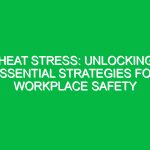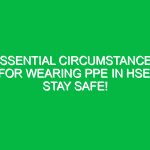Introduction
Hello team! Today, we’re here to conduct a toolbox talk focused on a critical aspect of our work Environment: Workplace Inspections. Understanding how to perform effective inspections not only helps us comply with health and Safety Regulations but also plays a vital role in preventing accidents and ensuring a safe workplace for everyone. Let’s dive into what Workplace Inspections entail, why they are essential, and how each of you can contribute to improving our Workplace Safety through these inspections.
Understanding Workplace Inspections
Workplace Inspections are structured examinations of the work environment to identify Hazards, assess risks, and ensure compliance with Safety Standards and regulations. They involve checking for potential dangers, evaluating safety Procedures, and ensuring that equipment is functioning correctly. In essence, these inspections are our first line of defense against accidents and injuries on the job.
The Importance of Workplace Inspections
Why do we conduct Workplace Inspections? Here are a few key reasons:
- Hazard Identification: Regular inspections help us identify potential Hazards before they cause harm. This proactive approach is essential in preventing workplace accidents.
- Compliance: Adhering to health and safety regulations is not just a legal requirement; it helps protect our employees and the organization as a whole.
- Continuous Improvement: Inspections allow us to assess our current safety practices, identify areas for improvement, and implement changes that enhance our overall safety culture.
- Employee Engagement: Involving employees in inspections fosters a culture of safety and accountability, empowering everyone to take ownership of their work environment.
Components of Effective Workplace Inspections
To conduct effective Workplace Inspections, we need to focus on several key components:
1. Planning and Preparation
Before we begin an inspection, it’s essential to plan. This involves setting objectives and determining the areas to inspect. Consider the following:
- What areas of the workplace have had previous issues?
- Are there any upcoming changes that may affect safety?
2. Conducting the Inspection
During the inspection, observe and evaluate various elements, including:
- Work Environment: Look for clutter, spills, and proper storage of hazardous materials.
- Equipment: Check machinery for safety guards and ensure they are functioning properly.
- Work Practices: Observe whether employees are following safety protocols, such as wearing Personal Protective Equipment (PPE).
3. Documentation
Documenting findings is crucial for tracking issues and ensuring accountability. Use a checklist to record observations, noting any hazards identified and recommendations for improvement. This documentation should be shared with the relevant parties to ensure follow-up actions are taken.
4. Follow-up Actions
After conducting the inspection, it’s essential to communicate findings and implement corrective actions. This may include:
- Training sessions to address knowledge gaps.
- Repairing or replacing faulty equipment.
- Updating safety protocols based on identified risks.
5. Review and Feedback
Regularly review inspection processes and outcomes to identify trends and areas for improvement. Asking for feedback from employees can help refine the inspection process and enhance safety culture.
Real-life Scenarios and Their Lessons
Let’s consider a couple of hypothetical scenarios to illustrate the importance of Workplace Inspections:
Scenario 1: The Slippery Floor
Imagine a team member slips on a wet floor that had not been marked or cleaned up promptly. If a proper Workplace Inspection had been conducted, this hazard would have been identified and addressed. Regular inspections would have ensured that spills were cleaned immediately, and wet floor signs were in place, preventing potential injuries.
Scenario 2: Faulty Equipment
In another scenario, an employee is using a piece of equipment that has not been inspected for months. During a Workplace Inspection, it is discovered that the safety guard is missing. This oversight could lead to serious injury. Regular inspections would have highlighted this issue, allowing for timely repairs and ensuring employee safety.
Best Practices for Conducting Workplace Inspections
To maximize the effectiveness of Workplace Inspections, consider the following Best Practices:
- Involve Employees: Encourage employees to participate in inspections. Their firsthand knowledge can provide valuable insights into potential hazards.
- Use a Checklist: Develop a comprehensive checklist tailored to your workplace. This ensures consistency and thoroughness during inspections.
- Schedule Regular Inspections: Make inspections a routine part of your operations. Regularity helps reinforce the importance of safety.
- Stay Updated: Keep up with changes in regulations and industry standards. Ensure your inspection practices reflect current requirements.
Potential Hazards and Risks
During Workplace Inspections, various hazards may be identified. Here are some common ones:
- Physical Hazards: Slips, trips, falls, and equipment-related injuries.
- Chemical Hazards: Exposure to harmful substances, inadequate labeling, and improper storage.
- Ergonomic Hazards: Poor workstation design leading to strains and repetitive motion injuries.
Regulations and Standards
It’s crucial to understand the regulations and standards that govern Workplace Inspections. Familiarize yourself with:
- The Occupational Safety and Health Administration (OSHA) guidelines.
- Local safety regulations specific to our industry.
- Company policies regarding health and safety practices.
Compliance with these regulations not only protects employees but also shields the organization from potential legal consequences.
Conclusion
In conclusion, effective Workplace Inspections are vital for maintaining a safe and healthy work environment. Regular inspections help us identify hazards, ensure compliance, and continuously improve our safety practices. Each of you plays a crucial role in this process; your commitment to safety can make a significant difference.
Thank you for your attention today. Let’s work together to ensure our workplace remains safe for everyone. Remember, safety is everyone’s responsibility, and your input and participation are invaluable during Workplace Inspections. If you have any questions or thoughts, feel free to share them now!


